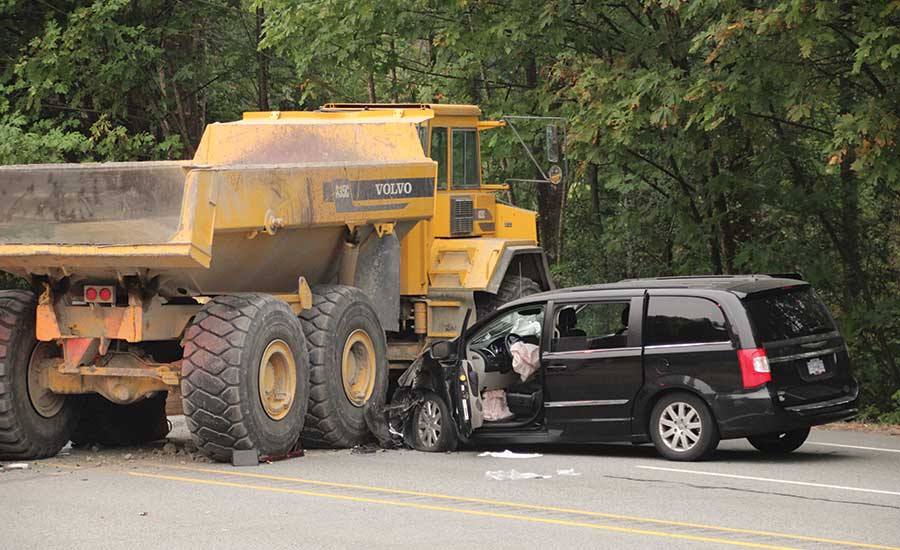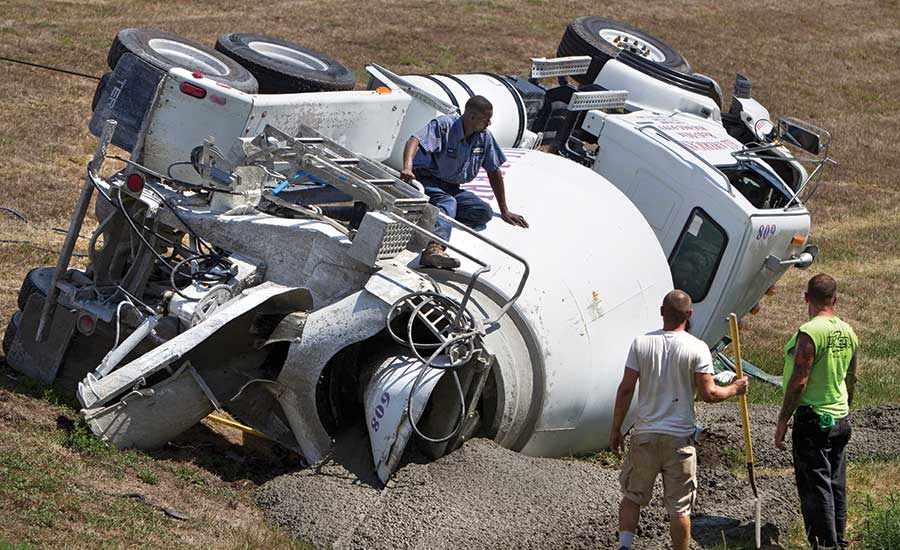Construction Accidents
How to Drive Down Dump and Concrete Delivery Truck Fatalities

The aftermath of a runaway haul-truck accident in Coquitlam, British Columbia, where the truck rolled while the driver was out of the cab, killing him and a motorist on an adjacent road.

Accidents over the years include a dump truck and car in Virginia in 2016 (above), an overturned concrete delivery truck in Missouri in 2012 (next photo) and a bicycle at the scene of a fatal collision in Michigan that killed the cyclist in 2009.
PHOTO AP: THE DAILY NEWS-RECORD, NIKKI FOX

Accidents over the years include a dump truck and car in Virginia in 2016 (previous photo), an overturned concrete delivery truck in Missouri in 2012 (above) and a bicycle at the scene of a fatal collision in Michigan that killed the cyclist in 2009.
PHOTO AP: THE KANSAS CITY STAR

Accidents over the years include a dump truck and car in Virginia in 2016, an overturned concrete delivery truck in Missouri in 2012 (previous photo) and a bicycle at the scene of a fatal collision in Michigan that killed the cyclist in 2009 (above).
PHOTO AP: THE GRAND RAPIDS PRESS, REX LARSEN

After driving, a safety check helps keep equipment in top condition at Allan Myers.
PHOTO: BRUCE BUCKLEY FOR ENR





It was midafternoon and 105˚ F last July 17 when Yadvinder Singh, a 30-year-old driver at the wheel of a dump truck on Highway 33 in Modesto, Calif., reached the last minutes of his life. Singh was working for a subcontractor named Destination Anywhere, which had provided the truck, and was on his ninth trip of the day when the right front tire blew, causing Singh to lose control and veer off the road, according to a lawsuit in state court filed by his widow. The truck overturned, crushing him.
The crash was just one of thousands of dump-truck accidents that occur each year in the U.S. Many, but not all, involve construction trucks. Together with ready-mix concrete delivery trucks, these vehicles have averaged 357 fatalities a year over the past seven years, with the number of deaths gradually rising. Thousands of other accidents inflict injuries and wreck the vehicles.
The good news is that for all types of large trucks, crashes have declined significantly since 2000, a sign that improved technology and efforts by federal regulators and insurance companies to promote safer driving are paying off. In an initiative aimed at preventing driver fatigue, fleet owners as of December had to comply with new rules for all trucks requiring electronic logging of hours worked. But the rules will affect long-haul trucking more than the mostly shorter-haul trucks that serve construction.
“If you want to be safe, you’ve got to have realistic times.”
– Michael Adams, Training Director, National Training Inc.
The gains in safety have leveled off, according to a review by ENR of all dump and ready-mix-delivery truck accident statistics where drivers, motorists or jobsite workers died over a seven-year period from 2009 to 2015. That is the latest year for which numbers are available from the website of the Federal Motor Carrier Safety Administration (FMCSA), which is part of the U.S. Dept. of Transportation. Mishaps involving dump trucks kill about 10 times as many people as those involving ready-mix trucks. The number of dump trucks used for construction, rather than for landscape or other services, isn’t broken out in the federal statistics.
A range of factors, including speeding, distracted driving, weariness, mismanagement by trucking subcontractors and careless or reckless operation by other vehicles on the road, have kept the number of fatal dump and ready-mix truck accidents at their current levels and heading up. Paying drivers by the haul provides incentives to speed and overwork, some experts say. The drivers themselves are getting younger, seem less committed and earn modestly. Pay for a nonunion driver running a concrete delivery truck averages $16.99 per hour, according to payscale.com, although it can go much higher. The average annual pay, according to bizfluent.com, is $38,000.
_______________________________________________________
Related Article: Linking Data to a Driver's State of Mind
_______________________________________________________
To be sure, despite a doubling of the number of registered large trucks of all kinds in the U.S., from 5.9 million in 1980 to more than 11 million in 2015, the number of fatal accidents was down by more than 1,000, to 4,050.
Speeding, the traditional nemesis of safe driving, now is rivaled by distraction. Speeding was cited in 298 deadly crashes in 2015, or 7.5%, according to the FMCSA report. The second most cited factor was distracted driving—related to cell phone use, eating or just simple daydreaming. It was cited in 242, or 6.1%, of cases. “We are seeing a lot more of the non-skid accidents,” says Carl Heinlein, senior safety consultant at the American Contractors Insurance Group. “People aren’t paying attention.”

SOURCE: FATAL ANALYSIS REPORTING SYSTEM VIA THE FEDERAL MOTOR CARRIER SAFETY ADMINISTRATION WEBSITE
That said, dump and ready-mix delivery trucks and their drivers face risks that long-haul truckers don’t normally encounter.
One is that dump and concrete drivers must navigate denser roads in the urban areas where construction work is concentrated. “The exposure for the risk-per-mile traveled for these vehicles is going to be higher,” says John Woodrooffe, the recently retired head of the University of Michigan Transportation Research Institute’s Vehicle Safety Analytics Group.
Demographics figure into the equation, too. The large baby-boom cohort is retiring and handing the steering wheel to less-experienced newcomers. The hope is that these new drivers, seasoned with instructions and advice gained from new telematic systems that monitor truck activity, can adapt to the demands of their trade and cut down the number of deadly accidents.
Dump Truck Hazards
Dump trucks are near the top of the list when it comes to deadly crashes, accidents that cause injuries requiring medical attention, or vehicle damage requiring towing, according to the FMCSA report. They were third in injury-causing accidents (5,332) and third in tow-aways (7,523), behind flatbed trucks and vans and enclosed box trucks.
“With dump trucks, ready-mix trucks, you really have to start thinking about the center of gravity,” says Ken Wengert, regional director for construction risk control at Travelers, the big insurer. “They are top- heavy vehicles, and drivers have to pay particular attention to turns.”
Speeding and careless cornering and backups cause many accidents. Dump-truck overloading—as in the fatal accident on Highway 33 in California cited earlier—can lead to tire blowouts and other problems. Importantly, in fatal accidents involving large trucks where a specific issue with the vehicle was identified, tires were the second most cited cause, according to the FMCSA report.
Where the accidents happen is also important. Nearly two-thirds of fatal accidents involving dump trucks take place on highways and streets outside the construction site, according to a 2012 report by the CPWR, a research, training and advocacy organization for construction safety.
Concrete-delivery trucks may require even more driver skill, with the rotation of concrete in the barrel constantly shifting the load and putting drivers at risk of rollovers if they take a turn too fast.
The top cause of rollovers for concrete trucks is drivers losing focus on two-lane country roads. In such accidents, the driver will veer onto the soft shoulder, and, as he or she tries to steer the truck back onto the roadway, the abrupt adjustment flips over the truck, says Gary Mullings, executive vice president of compliance and operations at the National Ready Mixed Concrete Association (NRMCA).
Uneven or excavated ground at jobsites also poses hazards to dump-truck drivers. So does pulling up too close to a trench, which can trigger a collapse. And right turns can be particularly difficult, with tons of concrete rotating above a driver’s head, making the truck vulnerable to rollovers, according to the FMCSA report.
Backup accidents are also a worry for concrete-delivery trucks, but using a spotter doesn’t always help and complicates matters. Examining backup accidents, the NRMCA found 48% of them occurred when a spotter was in place. Mullins advises drivers never to use a spotter unless they get out first and check whether the spotter understands the proper hand signals. If the driver can’t see the spotter in his mirror, he should stop the truck.
On North America’s busy roads, not every hazard originates with the truck, notes Joseph Cellura, president of insurer Allied World’s North American Casualty division. Merging passenger sedans have often collided with large trucks, he says.
“Oftentimes, sedan drivers hope to maneuver around these large vehicles, misjudge the gap or maneuver space and collide with the sides and rear of the larger trucks. The dump truck driver has limited options to avoid these collisions, and most often minor damage occurs from these accidentsm,” Cellura says.
Unfortunately, adds Cellura, in some of these situations, “the loads can shift, causing dump-truck drivers to lose control and roll over or cause the larger vehicle to drift.” Statistics bear him out. Almost four out of 10 accidents, or 38%, were blamed on another vehicle moving into the truck’s lane, according to the FMCSA data.
The fatal accident on Highway 33 in California last year highlights some of the other types of pressures endured by drivers employed by small trucking subcontractors. For his part, Singh was paid alternately by the hour or by the load, claims the attorney for his widow, who filed a lawsuit in Santa Cruz County Superior Court. The truck was allegedly overloaded by 5,000 pounds. And the overloading was part of a pattern of neglect, the attorney said in an interview.
The owner of the trucking subcontractor, Destination Anywhere, also allegedly told drivers to avoid going to weigh stations operated by the California Highway Patrol, according to the lawsuit. Efforts to reach Destination Anywhere for comment were unsuccessful.
Watsonville, Calif.-based Granite Construction, the general contractor that hired Destination Anywhere, is also a defendant in the lawsuit. A spokeswoman for Granite said it was company policy not to comment on pending litigation.
The British Columbia Roll-Away Accident
Other large contractors have run into trouble with routine truck activity. Worksafe BC, the government labor-safety agency in British Columbia, recently ordered M2K Construction Ltd. to investigate an accident at a state mental health facility jobsite last September in the contractor’s base city, Coquitlam, about 20 miles east of Vancouver (see photo p. 18-19). A 32-year-old driver, Robert W. Vanderhoef, had parked an articulating hauler on an incline and left the cab when the truck began to roll and killed him. The truck then continued downhill from the construction site and onto a busy road, crashing into traffic and killing a motorist, according to local media reports. M2K officials could not be reached for comment on the accident.
Are cameras and telematics—the electronic monitoring equipment that records any sudden braking or speeding and can help enforce hours of service in real time—the answer to all the errors and misjudgments a driver may commit? Not if the equipment isn’t used in tandem with follow-up that builds skill and good judgment, experts say.
A camera is only helpful, says Allied World’s Cellura, if the video is reviewed and used to improve performance. “Often the driving force behind telematics is company profitability through improved route efficiency and cargo security—it is not necessarily for safety,” he says. “If the camera is focused inside the trailer to prevent theft or the GPS is focused on the shortest route from A to B, then it is not helping to discourage distracted driving or excessive speeds.”
At A Driver Training School
At National Training Inc., Orange Park, Fla., the staff and trainers have a good grasp of what it takes to train skilled drivers—and of how technology must be combined with common-sense management. Michael Adams, a former student, is now the training director in charge of instructing students on how to run big rigs to qualify for a Class A Commercial Drivers License (CDL), which is the default license sought by aspiring drivers. (Few schools specialize in training for Class B, the license required for dump and concrete trucks.)
National Training partners with the National Center for Construction Education & Research, the curriculum and skills assessment nonprofit, and the Associated General Contractors. Adams is an NCCER master trainer and a curriculum instructor and he says drivers coming in for training are different from those who arrived two decades ago.
One important difference, he says, is that people coming for training now are less inclined to take responsibility for their own progress and less willing to submit to the bookkeeping requirements of the profession than previous generations. Some who were out of work during the recent recession may have “become lazy,” he says. Technology can help a lot. Along with the culture shift, “technology has developed, so the carriers are getting better and better with the safety features that are on the trucks,” Adams says.
The best way to get drivers to operate safely is to monitor their performance, which is easier now. But that doesn’t do everything human beings must do to foster safer truck use.
Despite the training available from many schools like National Training, Adams has seen cases of long-time drivers who are unaware of standard industry safety practices. In one instance, Adams evaluated a driver who had passed his original CDL test without formal training. After the driver’s supervisor became alarmed at his poor performance, he was sent to National Training, where Adams took notes during a test drive.
On a state CDL test on the road, a driver is allowed a maximum of 30 points. The driver in question scored 42 maximum points, more than 20 points higher on his test than Adams’ average graduating student. He didn’t know the training manual and had not developed his skills properly.
“According to him, he was seeing some of this information for the first time,” Adams says. But that wasn’t the end of the story.
Adams had seen the driver’s logbook and called the terminal manager’s attention to another reason for the driver’s record of violations. The times for his runs were very tight, so to make his schedule, he had to hustle. A lot of companies with dump-truck and concrete-delivery drivers pay by the load, so the driver had incentives to rush, says Adams.
Not everyone agrees that paying by the load undermines safety, but the message Adams sends is that responsibility for safe operation is shared between the driver and employer.
With Thomas F. Armistead and Richard Korman
Editor's note: This story file was updated April 26 to correct the description of CPWR.









